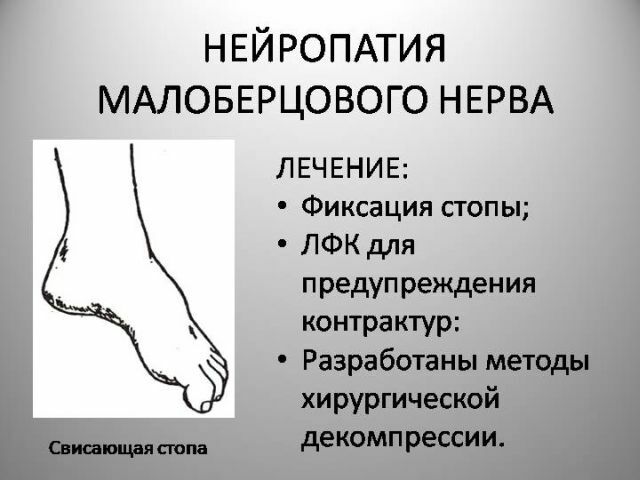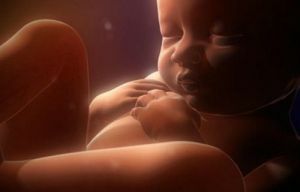 The very phrase perinatal period suggests that the perinatal CNS lesion develops in an unborn baby, that is, a fetus.
The very phrase perinatal period suggests that the perinatal CNS lesion develops in an unborn baby, that is, a fetus.
Perinatal central nervous system( CNVC) is a diagnosis that involves a disruption in the function of the fetal brain.
The entire period of the perinatal period is conditionally divided into three stages:
- from 28 weeks until the moment of birth, the period of the antenatal period lasts;
- the process of delivery itself is called the intranatal period;
- neonatal period is the time interval from the moment of birth and the first week of life.
In modern medicine, there is no exact name for the disease in the defeat of the fetal CNS, there is only a team, it is called PPNC or perinatal encephalopathy.
Perinatal CNS damage in newborns, manifests itself as a disruption in the functioning of the motor apparatus, a violation of speech and psyche.
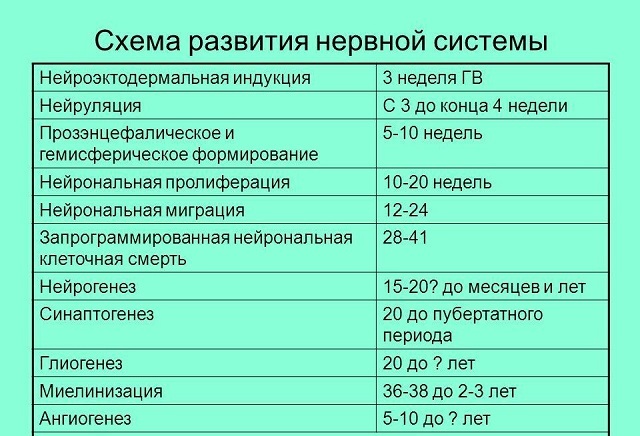
Causes and risk factors
The reasons why perinatal central nervous system damage can develop are quite diverse, among the most popular: the
- is a mother's somatic disease that is accompanied by chronic intoxication;
- the presence of acute infectious diseases or chronic foci of infection, while the future mother was carrying a child;
- in case a woman has a disturbed eating process, or she is not ripe for pregnancy and childbirth;
- changes in metabolism or the presence of a hereditary factor also entails a disorder of the nervous system in the unborn child;
- in the case of severe toxicosis, both at an early stage and at a late stage, or other problems with childbearing;
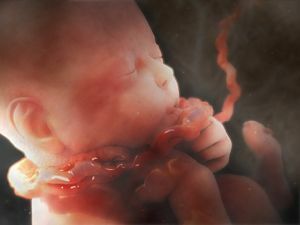
- environment is an important factor in the development of the disease;
- appearance of pathology during childbirth - it may be a weak labor activity, accelerated labor;
- if a child is born prematurely, then his body is not fully developed, therefore, against this background there may be a violation in the work of the central nervous system;
- the kids with the hereditary factor are at greatest risk of developing CNS lesions.
All other reasons for the emergence of PCCs are situational and to a greater extent they can not be predicted.
Classification and varieties of
syndromes The PCVC is conventionally divided into several periods, depending on the stage at which the disorder was detected and how it manifested itself.
The acute period lasts from 7 to 10 days, very rarely, but it can stretch out to a month. The period in which the recovery occurs can last up to half a year. If the child's body recovers slowly, then this period can take up to 2 years.
Pediatric neurologists distinguish the following varieties of perinatal CNS lesions, depending on the concomitant symptoms and the syndrome:
- Violation of the muscle tone of , which is accompanied by a complex of respiratory disorders. This syndrome is diagnosed according to abnormalities depending on the age of the newborn. In the initial period of the child's life, it is difficult to diagnose this syndrome, because in addition to this there is a physiological hypertonia.
- Syndrome associated with sleep disorder , jerking of the chin. This syndrome can be diagnosed only if the flatulence is excluded.
- Depression of the nervous system .Such a syndrome is diagnosed in children who are not active in the first months of their life, they sleep a lot of
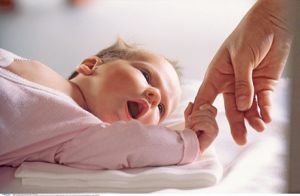 , their tone is lowered.
, their tone is lowered. - An unfavorable prognosis for a child if syndrome of intracranial hypertension has developed. Its main signs are increased excitability and nervousness, while the fontanel begins to swell.
- One of the most dangerous and severe syndromes with PCNC is convulsive , it is one of the most serious manifestations of perinatal CNS damage. In addition, any attentive mother can notice deviations in the health status of her child much more quickly than a neuropathologist doctor, if only because she watches him around the clock and more than one day.
In any case, the baby, living the first year with any( even minimal, but not passing) health problems requires repeated consultations with specialists( if necessary - additional examination), close supervision and medical measures if necessary.
Symptoms and Diagnostic Criteria
Not every mother who does not have a medical education can at first glance distinguish and determine that her child has a perinatal CNS lesion.
But, neurologists accurately determine the disease by the appearance of symptoms that are not characteristic of other disorders that are typical of the smallest patients.
Symptoms of PPCNS:
- when examining a baby, hypertonicity or hypotension of muscles can be detected;
- the child is excessively restless, anxious and agitated;
- appearance of shaking in the chin and extremities( tremor);
- appearance of seizures;
- , when examined by a hammer, markedly a violation of sensitivity;
- appearance of unstable stool;
- changes the heart rate;
- appearance of irregularities on the baby's skin.
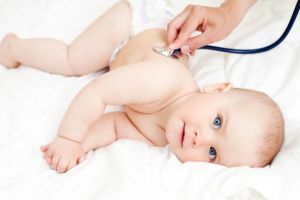 As a rule, after a year, these symptoms disappear, but then appear with a new force, so you can not start this situation.
As a rule, after a year, these symptoms disappear, but then appear with a new force, so you can not start this situation.
One of the most dangerous manifestations and consequences of PCNC in the absence of response to symptoms is the suspension of the development of the child's psyche. The speech apparatus does not develop, motor development is delayed. Also, one of the manifestations of the disease can become cerebrosthenic syndrome.
There are several ways of development of perinatal CNS damage in newborn children depending on the cause and the following symptoms, the analysis of which allows to put the initial diagnosis:
- If the lack of oxygen is clearly fixed, while the baby is inside the mother's body( hypoxia),
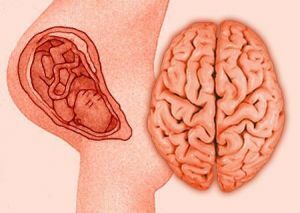 is diagnosed hypoxic ischemic lesion CNS.
is diagnosed hypoxic ischemic lesion CNS. - During childbirth, the tissue structure( this can be either the brain or the dorsal) can be damaged in the baby. In this case, we are talking about the traumatic lesion of the CNS, as a result of which there are changes in the work of the brain.
- In case of metabolic disorders, may appear metabolic and toxic-metabolic lesions of .This may be due to the use during pregnancy of alcohol, drugs, drugs, nicotine.
- Changes in the CNS in the presence of infectious diseases of the perinatal period .
Complex of therapeutic measures
In the case when the child develops an acute period of the disease, then first of all send him to the intensive care unit. Diuretics are used in case of suspected cerebral edema - dehydration therapy may be performed.
Depending on the symptoms of the baby, when properly selected, you can get rid of seizures, respiratory and cardiovascular disorders, and muscle disorders.
If the disease is difficult, then feeding the baby is through the probe. To restore the main functions of the central nervous system, as well as to reduce the manifestation of neurologic symptoms, the baby is assigned a whole complex of drugs:
- for the cramping of seizures, the course of reception of Radodorm, Finlepsin, Phenobarbital can be prescribed;

- if the child periodically spits up - designate Motilium or Cerucal;
- if there are disorders of the motor apparatus, Galantamine, Dibazol, Alizin, Prozerin are prescribed;
- in order to reduce possible hemorrhages recommend the use of Lidase drug.
Also nootropic drugs can be used in treatment that can restore trophic processes in the brain - Piracetam, Cerebrolysin, glutamic acid.
In order to stimulate the general reactivity to the newborn child, a course of therapeutic massage and special gymnastics is conducted.
In case the parents have detected at least one of the signs of the CNS lesions, it is necessary to urgently consult a doctor. Do not forget that the development of each child is an individual process.
Such individual characteristics of each newborn child in each specific case play an important role in the process of restoring the functions of higher nervous activity.
Perinatal injuries of the central nervous system:
The dangers and consequences of
There is an opinion among specialists that if the central nervous system of the fetus has been affected, it can not be completely restored. But neurologist-practitioners say the opposite. They say that if you treat the disease properly, you can achieve partial or complete recovery of the nervous system.
But even despite this optimistic forecast, if you look at all the diseases associated with the nervous system, 50% of their total number leads to disability, while about 80% of it is allocated to the perinatal lesion of the central nervous system.
Preventative measures
In order for the baby to be healthy, it is necessary: 
- completely abandon alcohol, drugs, smoking;
- to avoid infectious diseases during pregnancy;
- in case of indications to conduct heat treatment, which improves blood flow, and tissues are warmed;
- as soon as the baby is born, you can attend the underwater shower-massage course, which is held in warm water and has a beneficial effect on the development of muscle tone of the baby, if not, you can carry out manual massage under water.


